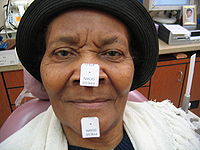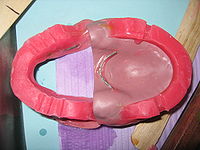
Vertical dimension of occlusion
Encyclopedia


Maxilla
The maxilla is a fusion of two bones along the palatal fissure that form the upper jaw. This is similar to the mandible , which is also a fusion of two halves at the mental symphysis. Sometimes The maxilla (plural: maxillae) is a fusion of two bones along the palatal fissure that form the upper...
and the mandible when the teeth are situated in maximum intercuspation
Maximum intercuspation
In dentistry, maximum intercuspation refers to the occlusal position of the mandible in which the cusps of the teeth of both arches fully interpose themselves with the cusps of the teeth of the opposing arch...
.
A VDO is not only possessed by people who have teeth, however; for completely edentulous individuals who do not have any teeth with which to position themselves in maximum intercuspation, VDO can be measured based on subjective signs related to esthetics and phonetics
Phonetics
Phonetics is a branch of linguistics that comprises the study of the sounds of human speech, or—in the case of sign languages—the equivalent aspects of sign. It is concerned with the physical properties of speech sounds or signs : their physiological production, acoustic properties, auditory...
.
In terms of esthetics, an appropriately measured VDO will appear to a layman's eye as an ordinary configuration of the patient's nose, lips and chin. An excessive VDO will appear as though the patient has something stuffed into their mouth, and the patient may not even be able to close his or her lips. A telltale indication of an excessive VDO is a patient straining to close his or her lips around the wax rims during VDO determination. Conversely, a deficient VDO will appear as though the patient's mouth has collapsed, and the chin appears too close to the nose; in essence, the patient would be over-closing his or her mouth because there would not be enough wax on the was rims to maintain the proper vertical dimension of occlusion.
In terms of phonetics, certain sounds are made by configuring the mouth in specific ways. The two sounds most commonly used to establish a patient's VDO are sibilant and fricative sounds. Sibiliant sounds are made by allowing the maxillary incisor
Incisor
Incisors are the first kind of tooth in heterodont mammals. They are located in the premaxilla above and mandible below.-Function:...
s to nearly touch the mandibular incisors, while fricative sounds are made by allowing the maxillary incisors to nearly touch the slightly inverted lower lip. By having the patient count upwards from fifty and then upwards from sixty, the dentist can watch and listen to the patient attempting to make first fricative and then sibilant sounds and adjust the wax rims accordingly.
A common trick is to ask the patient to say the name "Emma," as the position of the mandible immediately after completing the word is a rough estimate of the patient's proper VDO. The position after saying "Emma" is referred to as the vertical dimension at rest, or VDR. Historically, the VDO has been estimated at 3 mm less than VDR because a person will generally maintain their mandible at an opening of 3 mm when at rest.
There is another practical rule that applies to many mammals which give us a very practical way to find a suitable VDO. Take the distance between the corner of the eye and the same corner in the lips (in older people the measurement should be done a little more to mesial, closer to the nose, to avoid that downpointing tip )and using a ruler apply it between the center bottom of the nose (that rises from the upper lip) and lower tip of the mandible center. (In completely edentulous, with no teeth, as referred.) Maintaining centric position.
Changing the VDO may involve use of the Dahl concept
Dahl effect
The Dahl effect or Dahl concept is a concept used in dentistry where changes are planned in the occlusion of the dentition. Dahl first described this phenomenon: a Dahl appliance uses an anterior bite plane to increase the available interocclusal space available for restorations.It is of great...
Further reading
- Davis Henderson, Victor L. Steffel. McCRACKEN's Removable partial prosthodontics, 4th Edition, 1973.

